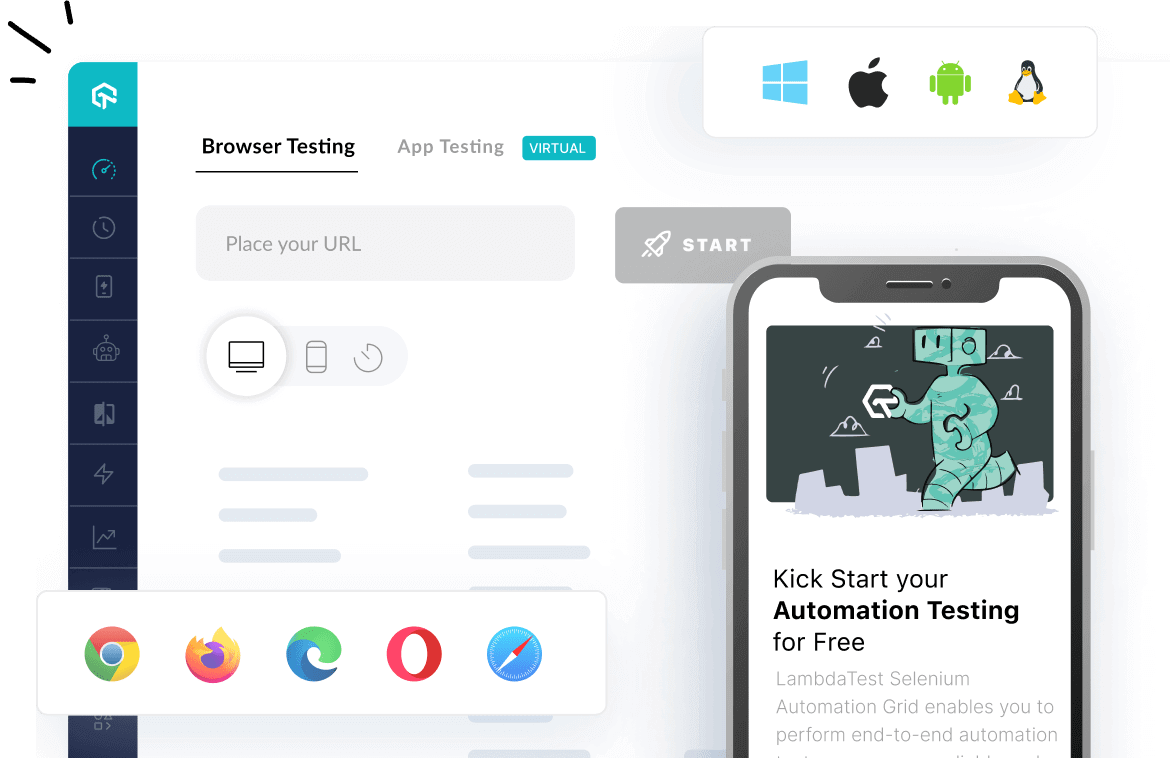How to use testSetParametersFromMap method of org.fluentlenium.core.url.UrlTemplateTest class
Best FluentLenium code snippet using org.fluentlenium.core.url.UrlTemplateTest.testSetParametersFromMap
Source: UrlTemplateTest.java
...182 assertThatIllegalArgumentException().isThrownBy(() -> urlParametersTemplate.put("param4", "test4"))183 .withMessage("Invalid parameter name: param4");184 }185 @Test186 public void testSetParametersFromMap() {187 UrlTemplate urlParametersTemplate = new UrlTemplate("/abc/{param1}/def{?/param2}/ghi{?/param3}");188 Map<String, String> parameters = new HashMap<>();189 parameters.put("param1", "test1");190 parameters.put("param3", "test3");191 urlParametersTemplate.put(parameters);192 assertThat(urlParametersTemplate.render()).isEqualTo("/abc/test1/def/ghi/test3");193 }194 @Test195 public void testAddParametersFromList() {196 UrlTemplate urlParametersTemplate = new UrlTemplate("/abc/{param1}/def{?/param2}/ghi{?/param3}");197 List<String> parameters = Lists.newArrayList("test1", "test2");198 urlParametersTemplate.addAll(parameters);199 assertThat(urlParametersTemplate.render()).isEqualTo("/abc/test1/def/test2/ghi");200 }...testSetParametersFromMap
Using AI Code Generation
1 public void testSetParametersFromMap() {2 Map<String, String> parameters = new HashMap<>();3 parameters.put("param1", "test1");4 parameters.put("param2", "test2");5 template.setParametersFromMap(parameters);6 }7}8 public void testSetParametersFromMap() {9 Map<String, String> parameters = new HashMap<>();10 parameters.put("param1", "test1");11 parameters.put("param2", "test2");12 template.setParametersFromMap(parameters);13 }14}15 public void testSetParametersFromMap() {16 Map<String, String> parameters = new HashMap<>();17 parameters.put("param1", "test1");18 parameters.put("param2", "test2");19 template.setParametersFromMap(parameters);20 }21}22 public void testSetParametersFromMap() {23 Map<String, String> parameters = new HashMap<>();24 parameters.put("param1", "test1");25 parameters.put("param2", "test2");26 template.setParametersFromMap(parameters);27 }28}testSetParametersFromMap
Using AI Code Generation
1package org.fluentlenium.core.url;2import static org.assertj.core.api.Assertions.assertThat;3import java.util.HashMap;4import java.util.Map;5import org.fluentlenium.core.FluentDriver;6import org.fluentlenium.core.FluentPage;7import org.junit.Before;8import org.junit.Test;9public class UrlTemplateTest {10 private UrlTemplate urlTemplate;11 public void before() {12 }13 public void testSetParametersFromMap() {14 Map<String, String> params = new HashMap<>();15 params.put("param1", "value1");16 params.put("param2", "value2");17 params.put("param3", "value3");18 urlTemplate.setParametersFromMap(params);19 }20 public void testSetParametersFromMapWithNullValue() {21 Map<String, String> params = new HashMap<>();22 params.put("param1", "value1");23 params.put("param2", "value2");24 params.put("param3", null);25 urlTemplate.setParametersFromMap(params);26 }27 public void testSetParametersFromMapWithEmptyValue() {28 Map<String, String> params = new HashMap<>();29 params.put("param1", "value1");30 params.put("param2", "value2");31 params.put("param3", "");32 urlTemplate.setParametersFromMap(params);33 }34 public void testSetParametersFromMapWithNullAndEmptyValue() {35 Map<String, String> params = new HashMap<>();36 params.put("param1", "value1");37 params.put("param2", "value2");38 params.put("param3", "");39 params.put("param4", null);testSetParametersFromMap
Using AI Code Generation
1public class UrlTemplateTest {2 public static void main(String[] args) {3 Map<String, String> map = new HashMap<>();4 map.put("param1", "value1");5 map.put("param2", "value2");6 urlTemplate.setParametersFromMap(map);7 System.out.println(urlTemplate.toString());8 }9}Blogs
Check out the latest blogs from LambdaTest on this topic:
Automating testing is a crucial step in the development pipeline of a software product. In an agile development environment, where there is continuous development, deployment, and maintenance of software products, automation testing ensures that the end software products delivered are error-free.
When most firms employed a waterfall development model, it was widely joked about in the industry that Google kept its products in beta forever. Google has been a pioneer in making the case for in-production testing. Traditionally, before a build could go live, a tester was responsible for testing all scenarios, both defined and extempore, in a testing environment. However, this concept is evolving on multiple fronts today. For example, the tester is no longer testing alone. Developers, designers, build engineers, other stakeholders, and end users, both inside and outside the product team, are testing the product and providing feedback.
Enterprise resource planning (ERP) is a form of business process management software—typically a suite of integrated applications—that assists a company in managing its operations, interpreting data, and automating various back-office processes. The introduction of a new ERP system is analogous to the introduction of a new product into the market. If the product is not handled appropriately, it will fail, resulting in significant losses for the business. Most significantly, the employees’ time, effort, and morale would suffer as a result of the procedure.
In today’s tech world, where speed is the key to modern software development, we should aim to get quick feedback on the impact of any change, and that is where CI/CD comes in place.
I was once asked at a testing summit, “How do you manage a QA team using scrum?” After some consideration, I realized it would make a good article, so here I am. Understand that the idea behind developing software in a scrum environment is for development teams to self-organize.
Automation Testing Tutorials
Learn to execute automation testing from scratch with LambdaTest Learning Hub. Right from setting up the prerequisites to run your first automation test, to following best practices and diving deeper into advanced test scenarios. LambdaTest Learning Hubs compile a list of step-by-step guides to help you be proficient with different test automation frameworks i.e. Selenium, Cypress, TestNG etc.
LambdaTest Learning Hubs:
- JUnit Tutorial
- TestNG Tutorial
- Webdriver Tutorial
- WebDriverIO Tutorial
- Protractor Tutorial
- Selenium 4 Tutorial
- Jenkins Tutorial
- NUnit Tutorial
- Jest Tutorial
- Playwright Tutorial
- Cypress Tutorial
- PyTest Tutorial
YouTube
You could also refer to video tutorials over LambdaTest YouTube channel to get step by step demonstration from industry experts.
Most used method in UrlTemplateTest
- testOnlyParameter
- testOnlyOptionalParameter
- testRender
- testRenderOptionalParameter
- testRenderNullOptionalParameter
- testRenderNullOptionalPathParameter
- testParse
- testParseWithEndingSlash
- shouldThrowExceptionIfUriHasInvalidSyntax
- testParseOptionalParameter
- testParseOptionalPathParameter
- testParseOptionalMiddleParameter
- testParseOptionalPathMiddleParameter
- testParseParametersFromQueryParameters
- testParseParametersFromPathAndQueryParameters
- testParseNotMatchingOptionalMiddleParameter
- testParseNotMatchingUrl
- testParseNotMatchingStartingUrl
- testParseMatchingWithTrailingSlash
- testDuplicateParameters
- testSetSingleParameter
- testThrowsExceptionForInvalidParameterName
- testSetParametersFromMap
- testAddParametersFromList
- testAddParametersFromListContainingNull
- getParameterNames
- getParameterOptionals
Try LambdaTest Now !!
Get 100 minutes of automation test minutes FREE!!

